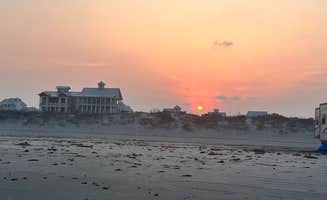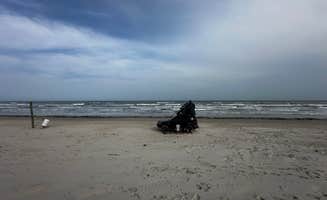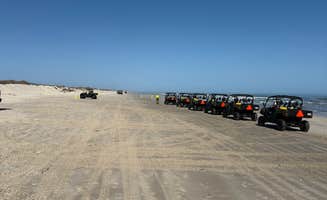Port Aransas features rustic camping options along its southern Texas coastline. The Gulf of Mexico waters in this region reach average temperatures of 72-84°F in summer months, with winter water temperatures dropping to 54-68°F. Sand conditions vary significantly after rain events, requiring different vehicle capabilities depending on beach section and recent weather patterns.
What to do
Fishing opportunities: At Padre Island South Beach, shoreline fishing is readily available directly from camp. "I loved beach camping, plenty of space with 20 miles of beach front free camping! Can't beat this," shares Diane M. about the extensive fishing access.
Wildlife observation: Visit the sand dunes at South Beach — Padre Island National Seashore where wildlife appears after sunset. "On some evenings after dark you can spot deer and coyote come out of the sand dunes to feed on seaweed and fish remains," notes Ron P., who frequently visits during winter months.
Beach bonfires: Digging fire pits in the sand is permitted at many beach locations. "Dig a hole and you can have a fire right on the beach it is absolute heaven!" reports Chastity H., who enjoyed the isolation after day visitors departed.
What campers like
Uncrowded off-season camping: During non-holiday periods, particularly winter months, many beach sections remain sparsely populated. "During the day you will have day visitors set up near you but not on top of you but at night it was like we were the only people on the beach!" explains Chastity H. about South Beach.
Natural setting: The primitive nature of the beach camping appeals to those seeking rustic experiences. "The largest barrier island in the world known for sheltering sea turtles," notes Chris B. who appreciates the natural environment at North Beach — Padre Island National Seashore.
Cost efficiency: Annual permits offer economical camping. "You can buy a yearly Beach Parking pass and can boondock on the beach for up to three days," reports Donell about the value at Port Aransas Permit Beach, highlighting the low cost for multiple camping trips.
What you should know
Supply preparation: No services exist on many beach sections. "This is PRIMITIVE (even 1 mile down there's no luxuries)= bring plenty of H20, food, GAS, supplies and a 4wd for the farther down areas," advises Lisa B. about camping at South Beach.
Weather challenges: Strong winds are common and can damage camping equipment. "The wind can easily blow over fiberglass pole tents (metal is best w/sandbag type weights & sand tent stakes, you will thank me!)," cautions Lisa B., who recommends proper gear for the conditions.
Sand management: Beach camping inherently involves dealing with blowing sand. "But my brain didn't compute that wind + sand = sand in tents, food, pants, etc!" admits Tucker B., revealing the persistent challenge of keeping sand out of belongings.
Tips for camping with families
Shade structures: Beach camping provides minimal natural shade, requiring portable options. "Make sure if you camp on the 50 miles of beach to bring long stakes to hold down your shade and tent - and camp way back to keep from waking up wet," recommends Chris B. from his experience at North Beach.
Wildlife activities: Children can participate in wildlife spotting after dark. "Ghost crabs will be rubbing up against your tent all night," notes James S., who took his daughters to enjoy stargazing and wildlife observation at North Beach.
Special events: Time visits to coincide with sea turtle releases. "We did happen to be there for the release of some sea turtles which was the highlight," shares James S., highlighting a memorable educational experience for families.
Tips from RVers
Beach parking regulations: RV parking orientation matters and violations result in costly fines. "We got a $281 ticket for parking parallel to the beach (we thought you only had to be perpendicular at the posts)," warns Angela R. at Port Aransas Permit Beach.
Dump station access: While beach camping lacks hookups, nearby facilities offer services. "I.B Magee allows you to dump and fill your tanks for $10," notes Angela R., providing essential information for extended RV stays.
Sand driving: Assess beach conditions before entering with an RV. "Very hard packed sand no trouble driving anywhere on it," reports Dennis about conditions during his stay, though sand firmness varies seasonally and after rain events.





